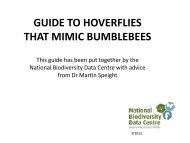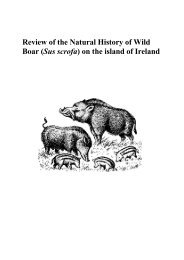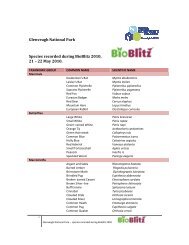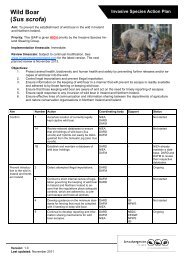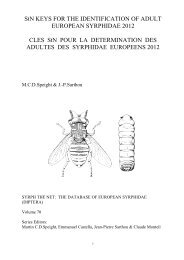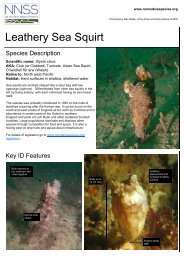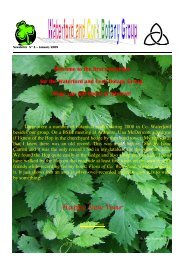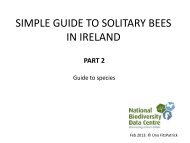StN DATABASE: CONTENT AND GLOSSARY OF ... - Pollinators
StN DATABASE: CONTENT AND GLOSSARY OF ... - Pollinators
StN DATABASE: CONTENT AND GLOSSARY OF ... - Pollinators
Create successful ePaper yourself
Turn your PDF publications into a flip-book with our unique Google optimized e-Paper software.
are endemic. Other elements of the ecosystem, such as pools and fallow fields, can be noted by<br />
addition of codes from other units (22, 16.2, 34, 37, 53, 54, 82, 87). As a whole, machair is an essential<br />
habitat for breeding waders such as Haematopus ostralegus, Vanellus vanellus, Charadrius hiaticula,<br />
Calidris alpine, Tringa totanus and Gallinago gallinago; it supports the healthiest European population<br />
of the threatened corncrake Crex crex).<br />
compost heap, urban park: stored accumulations of rotting debris of herbaceous vegetation resultant<br />
from management operations, including grass cuttings and fallen leaves.<br />
conifer plantation (gen.): planted, uniformly-aged, usually single-species stands of coniferous trees.<br />
CORINE 83.31.<br />
CORINE 83.31: CONIFER PLANTATIONS<br />
coniferous forest (gen.): forest and woodland of native coniferous trees other than floodplain and mire<br />
woods and with stands of overmature, mature and young (saplings/scrub) trees; formations dominated<br />
by coniferous trees, but including broad-leaved evergreen trees, are included. CORINE 42.<br />
CORINE 42: CONIFEROUS WOODL<strong>AND</strong>S; forests and woodlands of native coniferous trees other<br />
than floodplain and mire woods; formations dominated by coniferous trees, but comprising broadleaved<br />
evergreen trees, are included.<br />
conifers, scattered trees in open ground: see scattered trees in open ground (gen.).<br />
continental salt meadows, saltmarsh: continetal salt meadows belonging phytosociologically to the<br />
order Puccinellietalia distantis. CORINE 15.4.<br />
CORINE 15.4: CONTINENTAL SALT MEADOWS; Puccinellietalia distantis; Salt meadows of salt<br />
basins of interior middle Europe. Continental saltmarshes are remarkable, extremely threatened<br />
communities occurring in a few isolated stations of Saxony and Lower Saxony, Schleswig-Holstein,<br />
Thuringe, Hesse, Lorraine, Auvergne and the Midlands. They comprise this unit and continental<br />
glasswort swards (15.112). Habitats Directive, Natura 2000 code: 1340.<br />
corine: the CORINE ”habitats” classification system; a hierarchical, numerical categorisation of<br />
”habitat” categories, each of which is defined in the ”CORINE Biotopes Manual, Data<br />
specifications”, Part 2, published by the Office for Official publications of the European<br />
Communities, 1991. (ISBN 92-826-3211-3). Most CORINE ”habitat” categories are defined entirely<br />
in terms of flowering-plant communities. Macrohabitat categories which co-incide with numbered<br />
CORINE “habitat” categories have their corresponding CORINE code numbers given in this glossary,<br />
followed, word for word, by the definitions of those CORINE categories as provided in the CORINE<br />
Biotopes Manual mentioned above. The references provided in the CORINE Biotopes Manual, to<br />
published sources of information on the different CORINE categories, are not included here. The<br />
extension of the CORINE system to cover northern Europe has not yet been published in any readily<br />
accessible form. References made to northern European categories here follow Romau (1996). A<br />
French language version of the CORINE Biotopes Manual, restricted in its coverage to the CORINE<br />
habitat types known to occur in France, has recently become available- see Bissardon and Guibal<br />
(1998).<br />
Corylus thickets, Atlantic scrub: thickets of Corylus avellanae. CORINE 31.8C.<br />
cow dung, forest and open ground supplementary habitat: dung of cows/cattle, produced in situ, by<br />
grazing livestock (this does not include manure, imported from elsewhere and spread mechanically, as<br />
fertiliser).<br />
crop: CORINE 82: Crops; fields of cereals, beets, sunflowers, leguminous fodder, potatoes and other<br />
annually harvested plants. Faunal and floral quality and diversity depend on the intensity of agricultural<br />
use. If a tree layer is present, it can be indicated by simultaneous use of a code of 83 or 84 with the<br />
present one.<br />
culture macrohabitats: anthropogenic landscape features. CORINE 8.<br />
CORINE 8: Cultivated or built-up areas under the overwhelming influence of human activity; the<br />
natural vegetation cover has been totally replaced as a result of agricultural practices, urbanization or<br />
industrialization. A natural flora and fauna subsists mainly in areas of extensive and traditional<br />
20



